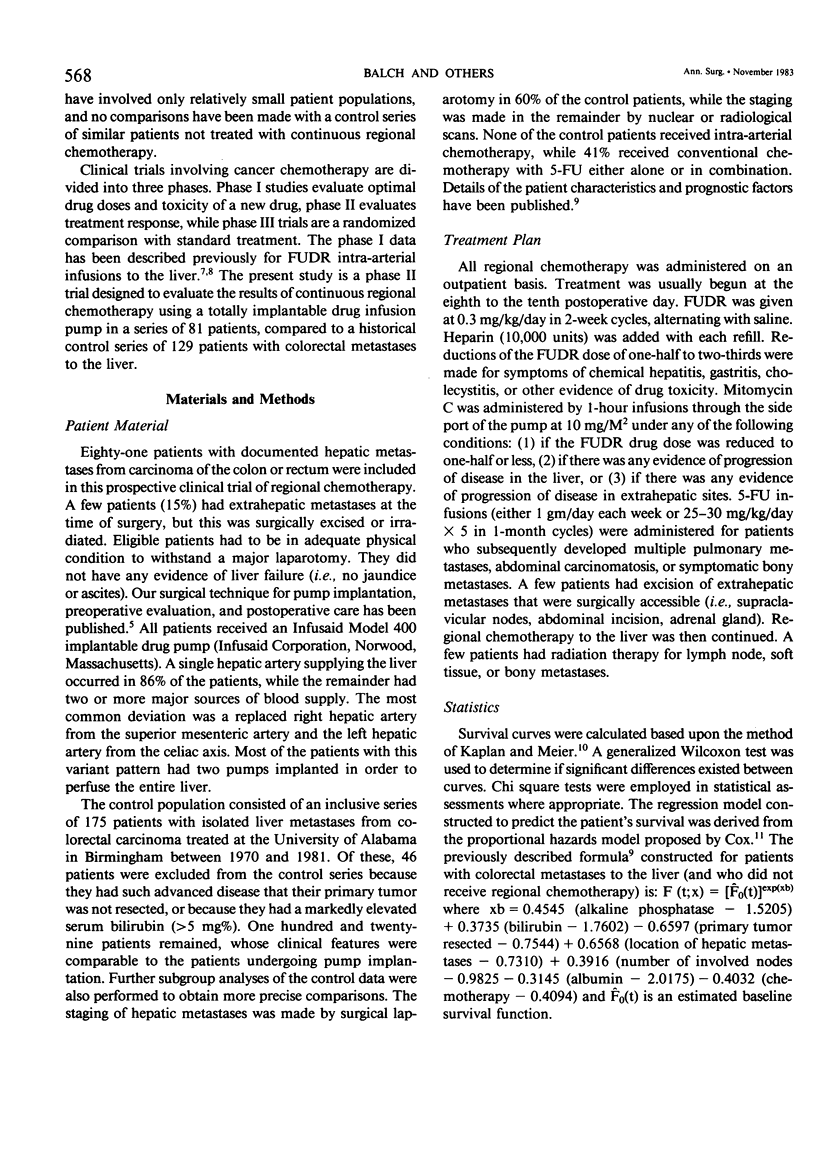Abstract
A prospective phase II evaluation of regional FUDR chemotherapy using a totally implantable drug infusion pump was conducted in 81 patients with colorectal metastases to the liver. The survival results were compared to a historical control group of 129 patients with isolated liver metastases. The two groups were comparable with respect to their dominant prognostic factors. The pump patients received their continuous chemotherapy on an outpatient basis and had an 88% response rate, as evidenced by a fall in their serum CEA levels by one-third or greater after two cycles of chemotherapy. By four criteria, the regional chemotherapy patients had an improved survival rate compared to the control series. First, the 1 year survival and median survival was better for the entire group of pump patients vs. controls (82% vs. 36%, 26 months vs. 8 months, p less than 0.0001). The survival for the regional chemotherapy patients was not influenced by the extent of tumor involvement, whether previous systemic 5-FU was given, or whether the patient had symptomatic disease. Second, the entire group of regional chemotherapy patients (including nonresponders) had a greater 1 year survival compared to the most favorable subgroup of control patients with the following characteristics: normal liver function tests, no symptoms, and only one lobe involved (82% vs. 66%, p = 0.009). Third, a subgroup of 49 pump patients, whose initial treatment for metastatic disease was regional chemotherapy (within 3 months of diagnosis) had a better 1 year survival than an exactly matched group of 49 control patients (67% vs. 30%, p = 0.000003). Fourth, the actuarial survival for all 81 pump patients was significantly better than predicted by a mathematical model constructed to predict the patient's clinical course based upon the seven dominant prognostic variables identified in a multifactorial analysis (82% survival at 1 year vs. 33% predicted survival). While liver metastases could be controlled in most patients, the major cause of death was tumor progression in extrahepatic sites, particularly lung metastases and abdominal carcinomatosis. Although it appears that regional chemotherapy with an implantable pump appears to prolong life by 12 to 18 months more than matched historical controls, these results must be confirmed by a randomized (phase III) prospective clinical trial.
Full text
PDF






Selected References
These references are in PubMed. This may not be the complete list of references from this article.
- Balch C. M., Urist M. M., McGregor M. L. Continuous regional chemotherapy for metastatic colorectal cancer using a totally implantable infusion pump. A feasibility study in 50 patients. Am J Surg. 1983 Feb;145(2):285–290. doi: 10.1016/0002-9610(83)90084-3. [DOI] [PubMed] [Google Scholar]
- Barone R. M., Byfield J. E., Goldfarb P. B., Frankel S., Ginn C., Greer S. Intra-arterial chemotherapy using an implantable infusion pump and liver irradiation for the treatment of hepatic metastases. Cancer. 1982 Sep 1;50(5):850–862. doi: 10.1002/1097-0142(19820901)50:5<850::aid-cncr2820500508>3.0.co;2-2. [DOI] [PubMed] [Google Scholar]
- Blackshear P. J., Dorman F. D., Blackshear P. L., Jr, Varco R. L., Buchwald H. The design and initial testing of an implantable infusion pump. Surg Gynecol Obstet. 1972 Jan;134(1):51–56. [PubMed] [Google Scholar]
- Blackshear P. J. Implantable drug-delivery systems. Sci Am. 1979 Dec;241(6):66–73. doi: 10.1038/scientificamerican1279-66. [DOI] [PubMed] [Google Scholar]
- Cady B. Hepatic arterial patency and complications after catheterization for infusion chemotherapy. Ann Surg. 1973 Aug;178(2):156–161. doi: 10.1097/00000658-197308000-00008. [DOI] [PMC free article] [PubMed] [Google Scholar]
- Clouse M. E., Ahmed R., Ryan R. B., Oberfield R. A., McCaffrey J. A. Complications of long term transbrachial hepatic arterial infusion chemotherapy. AJR Am J Roentgenol. 1977 Nov;129(5):799–803. doi: 10.2214/ajr.129.5.799. [DOI] [PubMed] [Google Scholar]
- Ensminger W., Niederhuber J., Dakhil S., Thrall J., Wheeler R. Totally implanted drug delivery system for hepatic arterial chemotherapy. Cancer Treat Rep. 1981 May-Jun;65(5-6):393–400. [PubMed] [Google Scholar]
- Grage T. B., Vassilopoulos P. P., Shingleton W. W., Jubert A. V., Elias E. G., Aust J. B., Moss S. E. Results of a prospective randomized study of hepatic artery infusion with 5-fluorouracil versus intravenous 5-fluorouracil in patients with hepatic metastases from colorectal cancer: A Central Oncology Group study. Surgery. 1979 Oct;86(4):550–555. [PubMed] [Google Scholar]
- Oberfield R. A., McCaffrey J. A., Polio J., Clouse M. E., Hamilton T. Prolonged and continuous percutaneous intra-arterial hepatic infusion chemotherapy in advanced metastatic liver adenocarcinoma from colorectal primary. Cancer. 1979 Aug;44(2):414–423. doi: 10.1002/1097-0142(197908)44:2<414::aid-cncr2820440207>3.0.co;2-3. [DOI] [PubMed] [Google Scholar]
- Reed M. L., Vaitkevicius V. K., Al-Sarraf M., Vaughn C. B., Singhakowinta A., Sexon-Porte M., Izbicki R., Baker L., Straatsma G. W. The practicality of chronic hepatic artery infusion therapy of primary and metastatic hepatic malignancies: ten-year results of 124 patients in a prospective protocol. Cancer. 1981 Jan 15;47(2):402–409. doi: 10.1002/1097-0142(19810115)47:2<402::aid-cncr2820470231>3.0.co;2-b. [DOI] [PubMed] [Google Scholar]
- SULLIVAN R. D., NORCROSS J. W., WATKINS E., Jr CHEMOTHERAPY OF METASTATIC LIVER CANCER BY PROLONGED HEPATIC-ARTERY INFUSION. N Engl J Med. 1964 Feb 13;270:321–327. doi: 10.1056/NEJM196402132700701. [DOI] [PubMed] [Google Scholar]
- SWINTON N. W., LEGG M. A., LEWIS F. G. METASTASIS OF CANCER OF THE RECTUM AND SIGMOID FLEXURE. Dis Colon Rectum. 1964 Jul-Aug;7:273–277. doi: 10.1007/BF02630531. [DOI] [PubMed] [Google Scholar]


